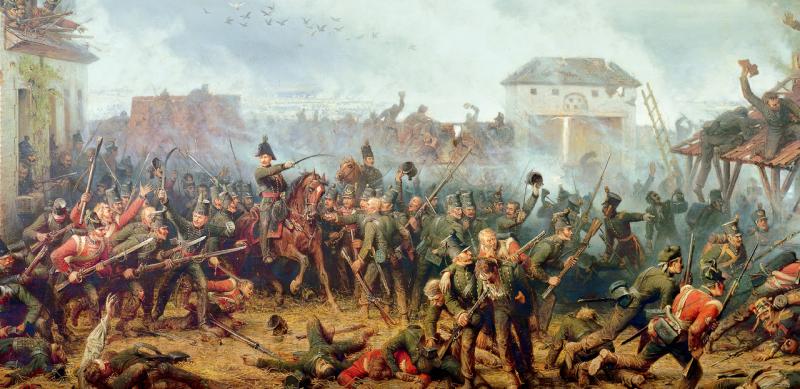French 55mm Round Shot Recovered From La Haye Sainte Waterloo
Recovered alongside the farm’s cast iron fireback and some other relic items of combat, such as soldiers thimbles, plus grenades, cannon balls etc. discovered around La Haye Sainte (named either after Jesus Christ's crown of thorns or a bramble hedge round a field nearby).
It is a walled farmhouse compound at the foot of an escarpment on the Charleroi-Brussels road in Belgium. It has changed very little since it played a crucial part in the Battle of Waterloo on 18 June 1815.
La Haye Sainte was defended by about 400 King's German Legion troops during the Battle of Waterloo. They were hopelessly outnumbered by attacking French troops but held out until the late afternoon when they retired because their ammunition had run out. If Napoleon Bonaparte's army had captured La Haye Sainte earlier in the day, almost certainly he would have broken through the allied centre and defeated the Duke of Wellington's army.
The capture of La Haye Sainte in the early evening then gave the French the advantage of a defensible position from which to launch a potentially decisive attack on the Allied centre. However, Napoleon was too late—by this time, Blücher and the Prussian army had arrived on the battlefield and the outnumbered French army was defeated.
Strategic importance
A view of the battlefield from the Lion's mound. On the top right are the buildings of La Haye Sainte. This view looks east, with Allied forces behind the road to the left (north) and French forces out of shot to the right(south)
The road leads from La Belle Alliance, where Napoleon had his headquarters on the morning of the battle, through where the centre of the French front line was located, to a crossroads on the ridge which is at the top of the escarpment and then on to Brussels. The Duke of Wellington placed the majority of his forces on either side of the Brussels road behind the ridge on the Brussels side. This kept most of his forces out of sight of the French artillery.
During the night from the 17th to the 18th, the main door to the courtyard of the farm was used as firewood by the occupying troops. Therefore, when the King's German Legion (KGL) was stationed in the farm at the morning of the battle they had to hastily fortify La Haye Sainte.
The troops were the 2nd Light Battalion KGL commanded by Major Georg Baring, and part of the 1st Light Battalion KGL. During the battle, they were supported by the 1/2 Nassau Regiment and the light company of the 5th Line Battalion KGL. The majority of these troops were armed with the Baker rifle with grooved barrels, as opposed to the normal Brown Bess musket of the British Army. The French troops also used muskets which were quicker to load than the Baker rifle but the latter was more accurate and had about twice the range of a musket.
Both Napoleon and Wellington made crucial mistakes about La Haye Sainte as it was fought over and around during most of the day. Napoleon failed to allocate enough forces to take the farm earlier in the day while Wellington only realised the strategic value of the position when it was almost too late.
Photo in the gallery of a range of 2" and smaller {Biscayen} French round shot recovered at Gemioncourt Farm that was located at Quatre Bras and was the scene of fighting between the Dutch and French in the battle which preceded Waterloo.
Biscayan bullets, are very large round shot used in very large calibre blunderbuss type guns used by the French at Waterloo and Quatre-Bras.
Code: 25045
145.00 GBP









